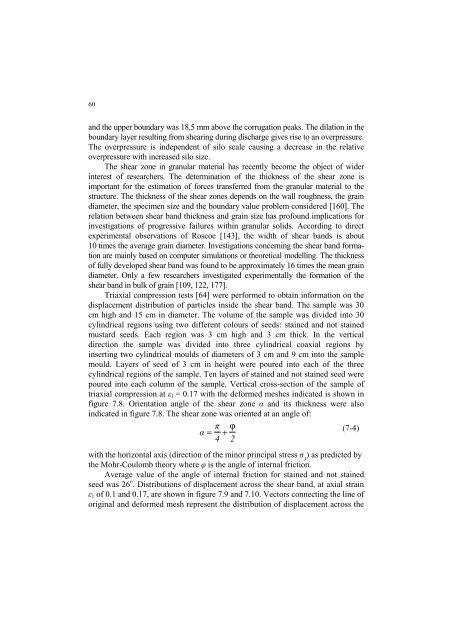Strona 2_redak - Instytut Agrofizyki im. Bohdana DobrzaÅskiego ...
Strona 2_redak - Instytut Agrofizyki im. Bohdana DobrzaÅskiego ...
Strona 2_redak - Instytut Agrofizyki im. Bohdana DobrzaÅskiego ...
Create successful ePaper yourself
Turn your PDF publications into a flip-book with our unique Google optimized e-Paper software.
60<br />
and the upper boundary was 18.5 mm above the corrugation peaks. The dilation in the<br />
boundary layer resulting from shearing during discharge gives rise to an overpressure.<br />
The overpressure is independent of silo scale causing a decrease in the relative<br />
overpressure with increased silo size.<br />
The shear zone in granular material has recently become the object of wider<br />
interest of researchers. The determination of the thickness of the shear zone is<br />
<strong>im</strong>portant for the est<strong>im</strong>ation of forces transferred from the granular material to the<br />
structure. The thickness of the shear zones depends on the wall roughness, the grain<br />
diameter, the spec<strong>im</strong>en size and the boundary value problem considered [160]. The<br />
relation between shear band thickness and grain size has profound <strong>im</strong>plications for<br />
investigations of progressive failures within granular solids. According to direct<br />
exper<strong>im</strong>ental observations of Roscoe [143], the width of shear bands is about<br />
10 t<strong>im</strong>es the average grain diameter. Investigations concerning the shear band formation<br />
are mainly based on computer s<strong>im</strong>ulations or theoretical modelling. The thickness<br />
of fully developed shear band was found to be approx<strong>im</strong>ately 16 t<strong>im</strong>es the mean grain<br />
diameter. Only a few researchers investigated exper<strong>im</strong>entally the formation of the<br />
shear band in bulk of grain [109, 122, 177].<br />
Triaxial compression tests [64] were performed to obtain information on the<br />
displacement distribution of particles inside the shear band. The sample was 30<br />
cm high and 15 cm in diameter. The volume of the sample was divided into 30<br />
cylindrical regions using two different colours of seeds: stained and not stained<br />
mustard seeds. Each region was 3 cm high and 3 cm thick. In the vertical<br />
direction the sample was divided into three cylindrical coaxial regions by<br />
inserting two cylindrical moulds of diameters of 3 cm and 9 cm into the sample<br />
mould. Layers of seed of 3 cm in height were poured into each of the three<br />
cylindrical regions of the sample. Ten layers of stained and not stained seed were<br />
poured into each column of the sample. Vertical cross-section of the sample of<br />
triaxial compression at ε 1 = 0.17 with the deformed meshes indicated is shown in<br />
figure 7.8. Orientation angle of the shear zone α and its thickness were also<br />
indicated in figure 7.8. The shear zone was oriented at an angle of:<br />
π ϕ<br />
(7-4)<br />
α = +<br />
4 2<br />
with the horizontal axis (direction of the minor principal stress σ 3<br />
) as predicted by<br />
the Mohr-Coulomb theory where φ is the angle of internal friction.<br />
Average value of the angle of internal friction for stained and not stained<br />
seed was 26 o . Distributions of displacement across the shear band, at axial strain<br />
ε 1 of 0.1 and 0.17, are shown in figure 7.9 and 7.10. Vectors connecting the line of<br />
original and deformed mesh represent the distribution of displacement across the
















